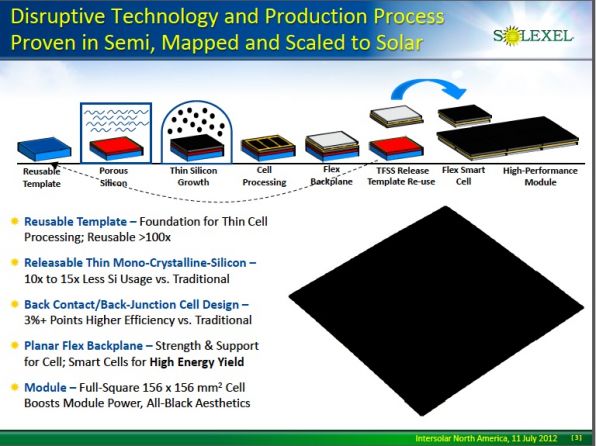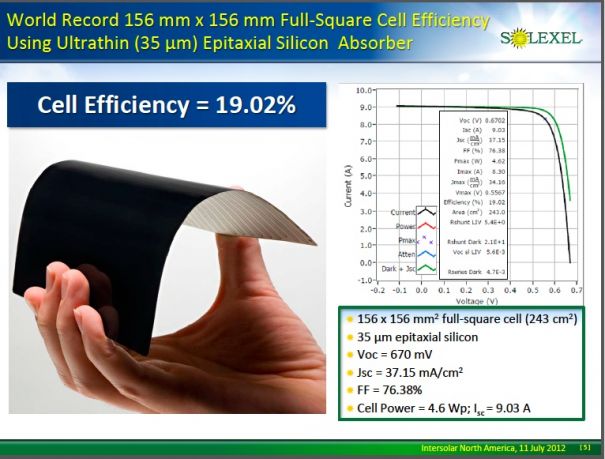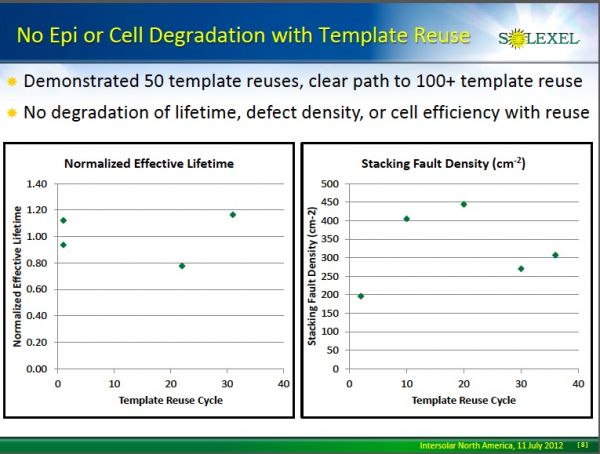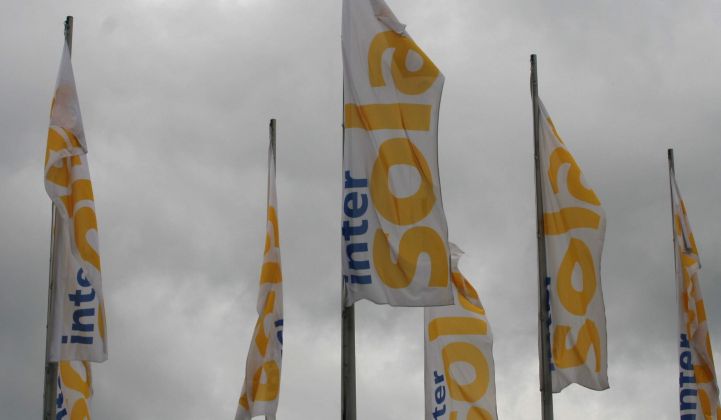We recently covered the Intersolar unveiling of Solexel, a thin-silicon technology startup hoping to bring 20-percent-efficient photovoltaic modules at a cost of $0.42 per watt to the market in 2014. At the time, the 70-employee firm was in the midst of raising its Round C of venture capital financing.
Last week the firm added $11.5 million to the $25 million raised in May, to bring the total of its C round to $36.5 million so far, according to documents filed with the U.S. Securities and Exchange Commission. On top of $113 million from its first two venture capital rounds, that brings the startup's total to just shy of $150 million.
But the company hasn't closed its C round yet. The thin-silicon startup is enlisting the aid of placement agent Gentry Securities, an affiliate of its C round lead investor, with a target of $60 million.
Here's our report from last week's Intersolar conference in San Francisco, detailing just what Solexel intends to do with the money:
It's the same solar startup story of high efficiency, low costs and low capex that has been pitched dozens of times to every cleantech VC or journalist since 2005. No firm has yet to execute on its promises at commercial scale. Perhaps Solexel is the company that can bring those claims to reality. If the firm can't, it won't be for lack of innovation or funding.
Investors include Kleiner Perkins, Technology Partners, Northgate Capital, DAG Ventures, GSV Capital, Spirox, Gentry Venture Partners, Oak Hill Investment Management, Ecofin, and The Westly Group. In its most recent round, the firm added GSV Capital, Gentry Venture Partners, and SunPower as investors, giving it at least one backer that actually knows a bit about solar technology. And one that shares some common technological traits with Solexel: high-efficiency cell performance and a back-contact cell architecture. Surviving due-diligence with SunPower speaks well of the startup's technology and path.
Solexel has also scored $17 million in DOE and NSF grants.
On the technological front, Solexel is looking to mass produce 35-micron-thick, high-performance, low-cost mono-crystalline solar cells using a lift-off technology based on a reusable template and a porous silicon substrate. The process ensures that the thin silicon is always supported during handling and processing while the back contact, p-type cell dispenses with the need for expensive silver, using aluminum instead. The process uses no wet steps, according to the CEO, Michael Wingert, a seasoned executive from the hard-disk drive industry. The process employs CVD on trichlorosilane gas at atmospheric pressure with silicon deposited at a rate of 2.5 microns per minute. The cell uses almost ten times less silicon than conventional c-Si cells, at about 0.5 grams per watt.
Mehrdad Moslehi, the CTO and founder of the firm, explained that at 156mm x 156mm, Solexel produces the largest back-contact cell in the industry. The firm will use a contract manufacturer to construct the modules, which will be available in frameless as well as framed versions. The firm's flexible cells do not need the support of a frame. In fact, the firm's cells don't need the support of glass, and it envisions flexible, non-glass sandwich panels in future product offerings.
As we reported last year, Solexel will be partnering in Malaysia to build the cells.
A resin and fiber carrier, akin to circuit board material, supports the thin cell and allows a switch to be added for module shading tolerance, possibly creating the space for some additional features in future generations.
Solexel, by virtue of its high efficiency and sleek black profile, is looking to appeal to the residential market initially and then to subsequently move into commercial rooftops and ground-mount applications.
The firm claims to have "eight top-tier strategic customers (leading global developers and distributors),"but the term 'customer' typically infers money changing hands for production-level products, so Solexel is a bit ahead of itself with that terminology. The firm also claims that its "production volume [is] fully subscribed by strategic customers."
The firm looks to ship 20-percent-efficient modules based on 21.5-percent-efficient cells in 2014 at a cost of $0.42 per watt at the module level.
Current conventional crystalline silicon manufacturers like Yingli and Trina are in the 15-percent to 16-percent module efficiency range with costs in the $0.83 per watt range. First Solar, one of the cost leaders, had an average line conversion module efficiency of 12.4 percent in the first quarter of this year at a cost of $0.73 per watt. But these bankable vendors are achieving these costs at immense scale and high yield with years of reliability testing.
Solexel still has a long way to go in proving its low costs and high efficiencies at volume in today's over-supplied market. If the firm can keep its promises, its cost and performance will make it a market leader. It the firm can't keep its promises, it joins the list of solar startups struck down by hubris and a ruthless market.



Other firms in the thin silicon business:
Twin Creeks builds equipment to manufacture extremely thin silicon solar cells that are 15 to 20 microns thick using ion-implant technology.
Ampulse claims that the firm’s "c-Si thin-film technology takes advantage of HW-CVD techniques to directly deposit a very thin layer of c-Si onto a uniquely textured and flexible metal substrate."
As reported by Ed Gunther, AstroWatt has developed a semiconductor-on-metal technology for creating thin silicon wafers. Gunther reports, "After partial processing, a monocrystalline silicon wafer is attached to an inexpensive, flexible 50-um metal foil also acting as the solar cell’s rear contact. Next, the foil, along with about 25 um of silicon, is exfoliated using a cleaving process." By reusing a 600-um wafer for multiple exfoliations, AstroWatt claims “up to 4X reduction in substrate cost” is possible, and the metal substrate is crucial for wafer handling in existing equipment." AstroWatt also stated the theoretical peak silicon solar cell efficiency can be achieved with a 25-um silicon wafer thickness.
Bandgap Engineering has developed tunable methods for nano-structuring silicon. The firm claims that the absorption of nano-silicon is enhanced by up to several orders of magnitude over bare silicon over a wide range of wavelengths. This enables nano-silicon to absorb the light in the first four microns versus the top 50 to 100 microns that bulk silicon needs to absorb most of the light. This could impact cell efficiency and direct manufacturing cost -- and make for much thinner wafers.
Crystal Solar uses a vapor deposition process for making thin crystalline silicon wafers. The firm has made wafers measuring 50 microns thick in its labs and hopes to get down to 20 microns.
The firm 1366 Technologies has a "direct wafer" technology whereby molten silicon is directly converted into wafers, which can then be processed into thin solar cells.
SiGen is also pursuing an implant-and-cleave process for wafers with thicknesses down to 20 microns.



